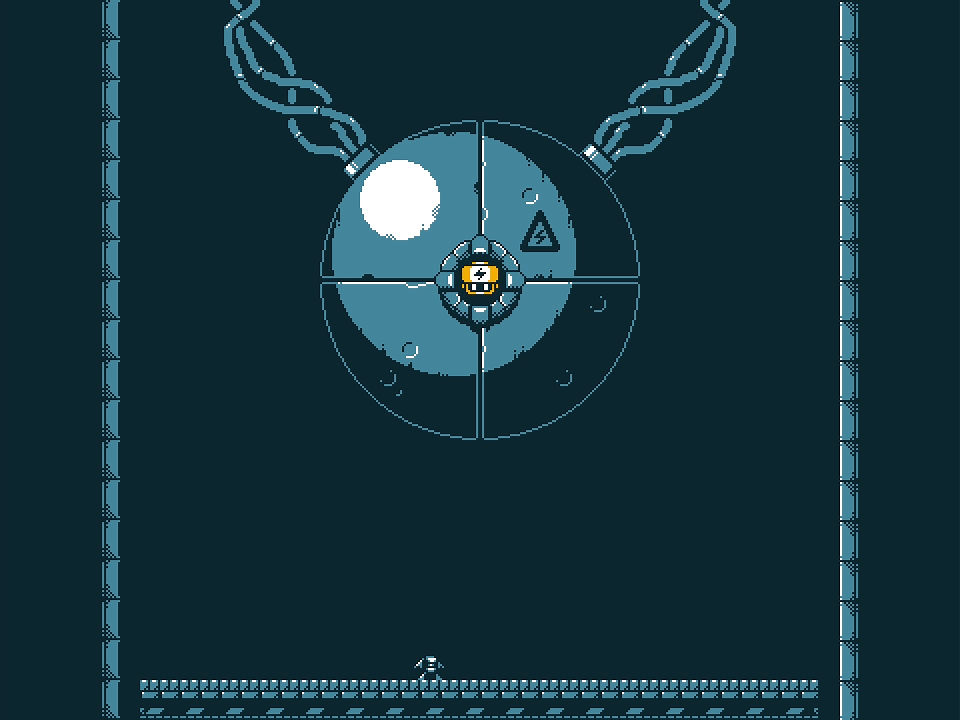ElecHead is a puzzle platformer about a robot on a lonely mission to restore power to Earth’s cities following an unidentified calamity. To accomplish this, the player character must travel to power stations spread across a small side-scrolling world. Their obstacle is the same ability which lets it repower the cities: its battery head. The world is constructed from chains and girders, and standing on or touching one sends electrical energy surging through them, activating any mechanisms it passes through on the way. Only by navigating this electrical obstacle course can I guide the player character to accomplish its goal and save the world from darkness.

What makes ElecHead special is its simplicity. Every situation I encounter is built on the player character’s simple moveset: move and jump. Any surface it moves or jumps onto is electrified by its battery-head, potentially activating a helpful moving platform, or just as likely, a deadly trap. The workaround to this sometimes-solution, sometimes-problem is hurling the player character’s head away from its body, potentially depowering a troublesome machine. The downside is its body will only function for a few seconds when disconnected from its head, so I must race to reconnect the two before the body expires without immediately reactivating a deadly trap. These three abilities—move, jump, and head throw—are used to solve every puzzle I encounter.
Each screen contains a single puzzle which must be solved to progress to the next one. One early puzzle eases me into the realities of existence as a battery-robot in a metal puzzle-box. I must get the player character across a room filled with ominous round orbs connected to narrow platforms. When I try to use the platforms to guide it across, its body electrifies them, activating the orbs which create deadly force fields blocking the path forward. I must carefully guide it through the force fields, a path that is much longer and more precarious than it first appears.

A few screens later, I encounter the first head-throwing puzzle. A gap too wide for the player character to jump across blocks the way forward, but I can also see the outline of a platform which will appear when it is electrified. I direct the player character to leap across the pit and throw its head at the leap’s apex, which falls down and electrifies the floor, extending the platform and catching its body before it falls to its destruction. From there it’s a few short steps forward to reclaim its head before its body expires.
With a checkpoint on almost every screen and instant respawns, there’s little punishment for experimenting, and many of ElecHead’s most devious puzzles require a bit of experimentation. But never too much experimentation; the simple moveset necessitates simple puzzle solutions, and though some require pinpoint timing to solve, the few times I get stuck are because I’m overthinking the problem.

ElecHead’s deliberately simplistic design has a direct impact on its length. With too many puzzles, things could begin to feel repetitive, but ElecHead wisely chooses to end once it has mined its simple premise of all its ideas. Though some puzzles are repeated, they appear in different configurations and contexts that still provide new challenges. Nevertheless, the result is a short playtime. I clear all of ElecHead’s primary goals in about two hours.
ElecHead creates some additional longevity through collectibles strewn across the map. These are all hidden in nooks and crannies that are easy to miss for eyes focusing only on completing the core mission.

The main collectibles are twenty chips hidden behind extra-challenging puzzles. Solving all of these puzzles and collecting every chip unlocks a second ending. More well-hidden are new palettes I can apply from the options menu. ElecHead carries its simplicity to its visuals, using no more than two colors in addition to black and white for depth. By default it contrasts cold blues with harsh yellows, but alternate color palettes transform the world into a friendlier blue and pink or even the different green shades of the classic Game Boy.
Finding all of these hidden collectibles adds about another two hours to my completion time.

ElecHead finds strength through simplicity. Its three moves are exploited to maximum effect, creating as many puzzles as its developer can piece together, then ending just when new ideas have run out. It’s a fine addition to any puzzle platformer’s collection and an impressive debut from its solo developer, Nama Takahashi, who created it as part of a game design class. I look forward to seeing what he will make in the future, as ElecHead suggests the start of an impressive career.